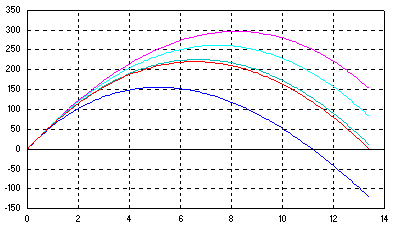Parameter Estimation |
|
Fitting a mathematical model to match the experimental data falls in the domain of parameter estimation. It is of particular practical importance when parameters are difficult to measure directly. To illustrate this fascinating subject let's modify the optimal trajectory example for the purpose of estimating the coefficient of drag from the measured trajectory data. The algorithm steps can be informally sketched with a pseudo-code, Except for the manipulation of measured data imported to the simulation
model, the solution is notably similar to the previous case.
A noteworthy difference appears in the "termination block" which is synchronized with the data sampling instants of the measurements stored in the file. The simulation runs are repeated automatically until the estimated parameter Cd is within prescribed tolerance. i.e. until the area (calculated by obj_fcn) between measured and calculated trajectories is minimized.  Trajectory (height vs. time) marked in red corresponds to the final
parameter A straightforward transition from the optimal trajectory setup to parameter estimation is largely due to native file data handling capabilities. The operational differences are reflected in the graph showing trial trajectories which are now of the same duration. |